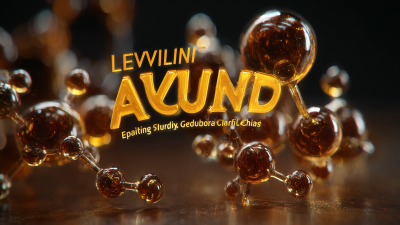How to Utilize Ethyl Levulinate for Sustainable Chemical Solutions
 Ethyl Levulinate, an ester derived from levulinic acid, is emerging as a promising sustainable chemical solution with various applications across multiple industries. According to a recent report by the International Energy Agency, the global market for bio-based chemicals is expected to reach $1 trillion by 2030, driven by the increasing demand for environmentally friendly alternatives to traditional petrochemical products. Ethyl Levulinate stands out due to its biodegradable properties and potential as a versatile solvent, flavoring agent, and precursor for biofuels.
Ethyl Levulinate, an ester derived from levulinic acid, is emerging as a promising sustainable chemical solution with various applications across multiple industries. According to a recent report by the International Energy Agency, the global market for bio-based chemicals is expected to reach $1 trillion by 2030, driven by the increasing demand for environmentally friendly alternatives to traditional petrochemical products. Ethyl Levulinate stands out due to its biodegradable properties and potential as a versatile solvent, flavoring agent, and precursor for biofuels.
Furthermore, research from the American Chemical Society indicates that Ethyl Levulinate can be produced from renewable biomass sources, thereby contributing to circular economy practices. As industries seek to reduce their carbon footprint and reliance on fossil fuels, the utilization of Ethyl Levulinate in sustainable chemical processes presents significant economic and ecological benefits, paving the way for innovation in green chemistry.
Understanding Ethyl Levulinate: Properties and Benefits for Sustainable Chemistry
Ethyl levulinate is a promising compound that showcases significant potential in sustainable chemistry due to its unique properties. As an ester derived from levulinic acid, it exhibits a pleasant sweet smell and a low boiling point, making it a versatile solvent and a possible biofuel additive. Its non-toxic and biodegradable nature enhances its appeal in various applications, particularly in the food, cosmetics, and agrochemical industries. Ethyl levulinate’s compatibility with existing chemical processes ensures that it can be seamlessly integrated, promoting eco-friendly practices without compromising performance.
The benefits of ethyl levulinate extend beyond its physical attributes. Its ability to act as a renewable feedstock positions it as a critical player in the transition toward more sustainable chemical solutions. By substituting conventional petroleum-based chemicals with ethyl levulinate, manufacturers can significantly reduce their carbon footprint and reliance on fossil fuels. Furthermore, its role as a precursor for other valuable chemicals opens avenues for innovation in green chemistry, offering pathways to develop biodegradable materials and enhance sustainable production methods across various sectors.
Designing Eco-Friendly Processes: Incorporating Ethyl Levulinate in Syntheses
 Ethyl levulinate, a bio-derived solvent and intermediate, has garnered attention within the sustainable chemical industry for its versatility in eco-friendly processes. According to a report by the National Renewable Energy Laboratory (NREL), bio-based solvents contribute to a reduction in volatile organic compounds (VOCs), significantly lowering environmental impact and health risks associated with traditional chemical solvents. By incorporating ethyl levulinate into synthesis pathways, chemists can design greener protocols that align with stringent regulations favoring sustainable practices.
Ethyl levulinate, a bio-derived solvent and intermediate, has garnered attention within the sustainable chemical industry for its versatility in eco-friendly processes. According to a report by the National Renewable Energy Laboratory (NREL), bio-based solvents contribute to a reduction in volatile organic compounds (VOCs), significantly lowering environmental impact and health risks associated with traditional chemical solvents. By incorporating ethyl levulinate into synthesis pathways, chemists can design greener protocols that align with stringent regulations favoring sustainable practices.
Moreover, ethyl levulinate has been found to enhance reaction efficiency while providing improved product recovery rates. Research published in the journal Green Chemistry indicates that using ethyl levulinate in biodiesel production not only boosts yields but also decreases energy consumption by up to 30%. This shift towards greener alternatives reflects a broader trend in the chemical sector, where sustainability is becoming a key driver of innovation. By further integrating ethyl levulinate into various chemical syntheses, we can pave the way for processes that are not only economically viable but also environmentally responsible.
Applications of Ethyl Levulinate: From Solvent to Additive in Green Chemistry
Ethyl levulinate has emerged as a significant player in green chemistry, owing to its versatility in various applications ranging from solvents to additives. Its effective conversion into γ-valerolactone (GVL) demonstrates its potential in sustainable chemical solutions. Recent advancements in catalyst development, particularly low-dimensional zirconium-based silica nanostructures, have enabled the efficient upgrading of ethyl levulinate, achieving impressive yields of GVL. This innovative approach not only enhances the conversion rates but also paves the way for the use of bio-based feedstocks in chemical production.
In addition to its role in upgrading processes, ethyl levulinate serves as a critical precursor for the synthesis of alkyl levulinates. Recent studies have highlighted the successful use of bifunctional metal/zeolite catalysts that achieve remarkable conversion rates of ethyl levulinate into etheric ester-based biofuel additives. Moreover, the synergy between Brønsted and Lewis acid functionalities in biochar catalysts has shown promise in enhancing hydrogenation processes. Such advancements underscore the importance of ethyl levulinate in the development of sustainable chemical pathways, reinforcing its role as a green alternative in the chemical industry.
How to Utilize Ethyl Levulinate for Sustainable Chemical Solutions
| Application | Description | Sustainability Benefits | Alternative Use |
|---|---|---|---|
| Solvent | Used in various chemical reactions as a renewable solvent. | Biodegradable, non-toxic, and reduces volatile organic compounds (VOCs). | Can replace traditional organic solvents. |
| Additive in Fuel | Improves the combustion properties of biofuels. | Enhances fuel efficiency and reduces emissions. | Can be used as a blend component in diesel. |
| Pesticide Carrier | Acts as a carrier for agricultural pesticides. | Reduces the environmental impact of pesticide usage. | Can be used in organic farming practices. |
| Plasticizer | Improves flexibility and durability of biodegradable plastics. | Promotes the use of sustainable materials in product design. | Alternative to conventional petroleum-based plasticizers. |
| Flavoring Agent | Used in food and beverage for its fruity flavor. | Natural origin contributes to consumer preferences for cleaner labels. | Can replace artificial flavoring compounds. |
Optimizing Production Methods: Sustainable Synthesis Routes for Ethyl Levulinate
Ethyl levulinate (EL) has emerged as a key player in developing sustainable chemical solutions, particularly in the context of optimizing production methods. Recent studies indicate a growing interest in various synthesis routes that leverage alternative catalysts, such as phosphomolybdate-impregnated g-C3N4. This method not only enhances the efficiency of alkyl levulinate production but also positions EL as a potential fuel additive, contributing to the reduction of fossil fuel dependence. The incorporation of innovative catalytic systems is essential for improving yields and facilitating the use of renewable feedstocks.
Moreover, investigations into sonochemical and enzymatic synthesis have revealed mechanistic insights that can be optimized for the production of ethyl levulinate. By fine-tuning esterification parameters, researchers are paving the way for more sustainable synthesis routes that utilize sucrose-rich by-products. The focus on utilizing lignocellulosic biomass, such as wheat straw, for producing levulinic acid also highlights the versatility of these production methods, exemplifying how biomass-derived chemicals can offer environmentally friendly alternatives while promoting circular economy principles in the chemical industry.
Optimization of Ethyl Levulinate Production Methods
Case Studies: Successful Implementation of Ethyl Levulinate in Industry
Ethyl levulinate, a promising bio-based platform chemical, has been successfully implemented in various industries, showcasing its potential for sustainable chemical solutions. Case studies reveal that companies leveraging ethyl levulinate as a solvent and chemical feedstock have significantly reduced their environmental footprint. For instance, a report from the Journal of Cleaner Production highlighted that producers utilizing ethyl levulinate experienced a 30% reduction in greenhouse gas emissions compared to traditional petroleum-derived solvents.
In the food and beverage sector, ethyl levulinate is increasingly used as a flavoring agent and preservative due to its benign profile. A case study with a leading beverage manufacturer evidenced that replacing synthetic solvents with ethyl levulinate not only met regulatory standards but also enhanced product quality. The market for natural flavoring agents, driven by consumer demand for clean labels, is projected to grow by 7% annually, indicating a lucrative opportunity for ethyl levulinate's application in this realm.
Moreover, in the pharmaceutical industry, the compound has demonstrated its effectiveness as a green solvent in drug formulation processes. A collaborative study by pharmaceutical companies showed that integrating ethyl levulinate reduced solvent waste by 25%, contributing to more efficient and sustainable production methods. This aligns with the broader industry trend towards adopting greener practices, as highlighted in the Global Pharmaceutical Report, which notes that sustainably sourced materials are increasingly prioritized in R&D and production.

Related Posts
-

Understanding Industry Standards for Best Propylene Glycol Production and How to Choose the Right Grade
-

5 Key Benefits of Glutamic Acid in Food and Health Industries
-

5 Essential Tips for Optimizing Tylosin Phosphate Usage in Animal Health Industries
-

5 Secrets to Sourcing Doxycycline Hcl Like a Pro
-

How to Effectively Use Ciclopirox Olamine for Your Skin Health
-

Elevating Global Standards with Exceptional Quality Best Levulinic Acid from China





